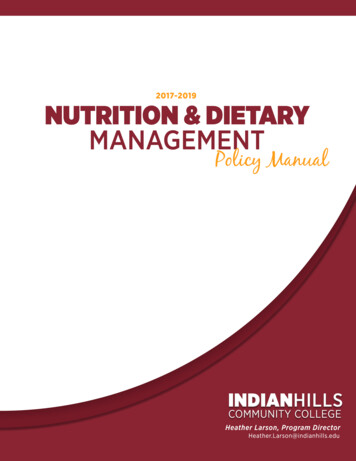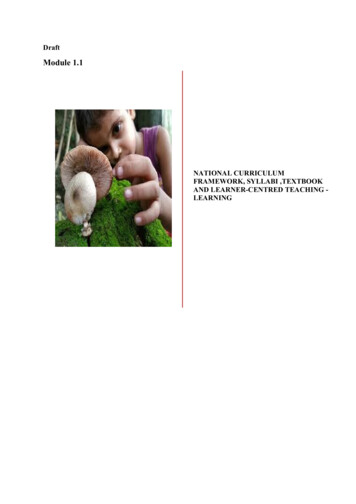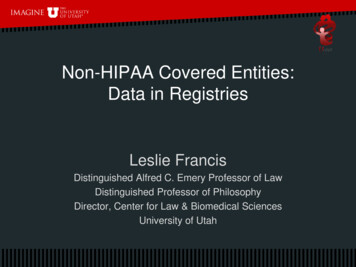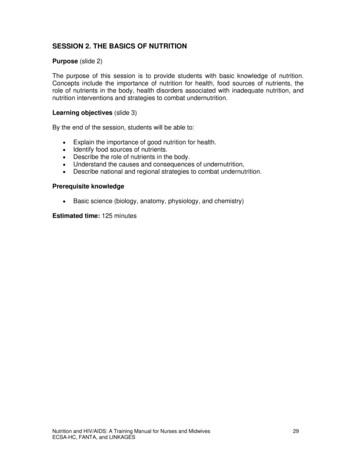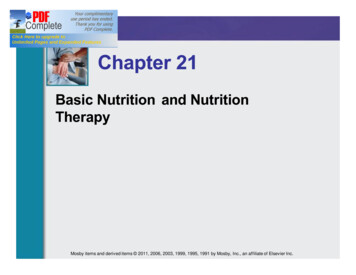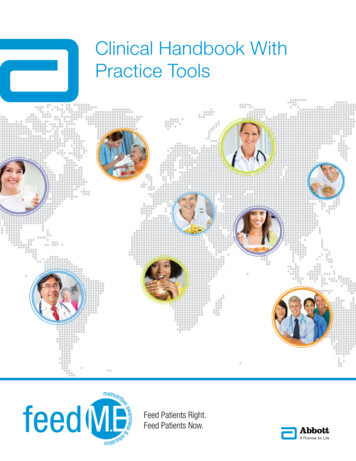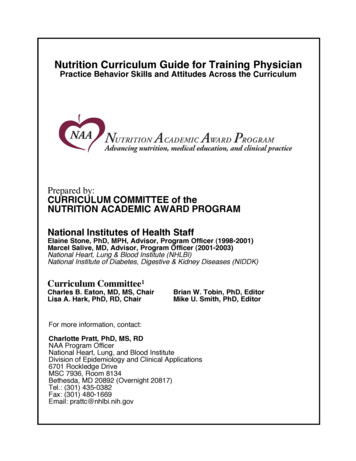
Transcription
Nutrition Curriculum Guide for Training PhysicianPractice Behavior Skills and Attitudes Across the CurriculumPrepared by:CURRICULUM COMMITTEE of theNUTRITION ACADEMIC AWARD PROGRAMNational Institutes of Health StaffElaine Stone, PhD, MPH, Advisor, Program Officer (1998-2001)Marcel Salive, MD, Advisor, Program Officer (2001-2003)National Heart, Lung & Blood Institute (NHLBI)National Institute of Diabetes, Digestive & Kidney Diseases (NIDDK)Curriculum Committee1Charles B. Eaton, MD, MS, ChairLisa A. Hark, PhD, RD, ChairBrian W. Tobin, PhD, EditorMike U. Smith, PhD, EditorFor more information, contact:Charlotte Pratt, PhD, MS, RDNAA Program OfficerNational Heart, Lung, and Blood InstituteDivision of Epidemiology and Clinical Applications6701 Rockledge DriveMSC 7936, Room 8134Bethesda, MD 20892 (Overnight 20817)Tel.: (301) 435-0382Fax: (301) 480-1669Email: prattc@nhlbi.nih.gov
Curriculum Committee MembersLars Berglund, MDFrances Burke, MS, RDDarwin Deen, MD, MSMarie Dent, PhDMarilyn Edwards, PhD, RDMarion Fitzgibbon, PhDFrank A. Frankin, MD, PhDKim Gans, PhD, MPH, LDNJoel Gordon, MDSteven Havas, MD, MPHDoug Heimburger, MDRonald Kahn, MDRobert Knopp MDNancy Krebs, MDRobert Kushner, MDTanis Mihalynuk, PhD, RDScott Mcintosh, PhDPatrick, McBride, MD, MPHElizabeth Moreno, MA, MSGail Morrison, MDThomas Pearson, MD, PhD, MPHElizabeth Ross, MDCraig Scott, PhDNancy Sheard, DScMike Smith, PhDColleen Smith, PhDLinda Snetselaar, PhD, RDSachiko T. St. Jeor, PhD, RDAlvin Telser, PhDAndrew Tershakovec, MDBrian Tobin, PhDLinda Van Horn, PhD, RDTracy Veach, EdDAlan Walker, MDFrancine Welty, MD, PhDChristine Williams, MDMargo Woods, DScJudy Wylie-Rosett, EdD, RDCharles B. Eaton, MD, MS1 See Appendix 2 for further information on committee members, staff and a/guide.htm
Nutrition Curriculum Guide for Training PhysiciansPractice Behavior Skills and Attitudes Across the CurriculumNutrition Curriculum Guide For Training PhysiciansTable of ContentsPreface/User’s GuideDedicationA.Practice Behavior Skills Across the CurriculumA.1Practice Behavior Skills Across the CurriculumA.2Attitudes Across the CurriculumB.Overview and Nutrition BasicsB.1Nutrition PrinciplesB.2Community and Population HealthB.3Behavioral Science PrinciplesB.4Nutrition AssessmentB.5Physical ActivityC.LifespanC.1PediatricsC.2Young Adulthood/Middle AgeC.3GeriatricsC.4Women’s HealthD.Cardiovascular System (See also Physical Activity, Obesity, and Diabetes Mellitus)D.1Hyperlipidemia and AtherosclerosisD.2HypertensionD.3Heart Failure and CardiomyopathyE.Metabolic/Endocrine SystemsE.1ObesityE.2Diabetes MellitusF.Other Organ oneG.Other AreasG.1Nutrition SupportG.2Contemporary TrendsH.AppendicesH.1Nutrition Academic Award Program Principal InvestigatorsH.2Nutrition Curriculum Guide for Training Physicians ContributorsH.3Description of How the Guide Was Developed8/30/2002
Nutrition Curriculum Guide for Training PhysiciansPractice Behavior Skills and Attitudes Across the Curriculum8/30/2002Nutrition Curriculum Guide for Training PhysiciansPreface/User’s GuideThe purpose of this preface is to serve as both a brief introduction to this document anda User’s Guide to assist readers in finding the information most useful to them.Background and Introduction: In recognition of the need to develop and enhanceundergraduate and graduate medical nutrition education, the National Heart Lung andBlood Institute (NHLBI) and the National Institute of Diabetes and Digestive and KidneyDiseases (NIDDK) established the Nutrition Academic Award (NAA) Program in 1997(www.nhlbi.nih.gov/funding/training/naa). The NAA Program provided 21 U.S. medicalschools with five-year grants to support nutrition education programs for medicalstudents, medical residents, and clinical faculty (Appendix). This Nutrition CurriculumGuide for Training Physicians represents the efforts of medical nutrition educators atthese schools. The section topics were selected after reviewing the existing literatureand curricula. Members of the NAA Curriculum Committee were then assigned the taskof creating or reviewing first drafts of a given section.Each section was written with four components: a brief list of content areas,consistent with previous curriculum recommendations for nutrition, and learningobjectives written for knowledge, practice behavior skills, and attitudes. After eachsection was reviewed, the entire document was revised by Drs. Brian Tobin and MichaelSmith at Mercer School of Medicine to ensure that the learning objectives usedlanguage consistent with Bloom’s taxonomy and included objectives that representedeach area of development of expertise (cognitive and problem-solving). At this point theobjectives were submitted to a consensus-generating “Delphi” process with theassistance of Dr. Craig Scott, at the University of Washington School of Medicine.Nutrition education spans the continuum for medical students, residents, andspecialists and we have attempted to address this issue by listing objectives asappropriate for each of these levels. Learners at each level would be expected to havesome degree of competency in those objectives listed for learners below their level. TheDelphi process allowed us to prioritize objectives and we have done this by placing inBOLD type the items ranked in the top 1/3 of all objectives at each learner level.Objectives that follow are not in order of priority. Clearly, an individual programs’ abilityto accomplish these objectives depends upon many factors (educational priorities,resources, etc.).This curriculum is designed to be used by medical educators and evaluators,curriculum committees, Deans offices, etc. to assist in creating, evaluating, modifying,and updating nutrition curricula at individual programs (medical schools, residency andfellowship training programs). We have organized the Chapters in a way that allowsindividual course leaders to rapidly identify those areas relevant to their course.Curriculum committees will be most interested in the global behavior and attitude
Nutrition Curriculum Guide for Training PhysiciansPractice Behavior Skills and Attitudes Across the Curriculum8/30/2002objectives listed first in this manual. These objectives were common themes acrossmany of the individual sections.The goal of any curriculum is to elucidate for teachers and learners theknowledge, practice behavior skills, and attitudes that are expected for competence andmastery. It also allows for specific evaluation strategies to be created. These objectivesare already in use at many of the NAA schools to help define and refine teaching efforts.They have begun to appear in syllabi, chapter headings, lecture introductions, coursesummary guides, etc. Evaluation strategies have been (and will continue to be)developed to assist educators in assessing student’s progress in meeting theseobjectives.The National Board of Medical Examiners (NBME) who administers the USMLEStep 1, 2 and 3 exams has developed a nutrition sub-score for the Step 1 exam. TheNBME has approved members of the NAA Program to review the Step 1, 2 and 3exams in 2002 in order to assess the quantity and quality of the nutrition-related items.This process will also determine if it is appropriate to recommend a nutrition-subscorefor the Step 2 and Step 3 exams. As schools modify their nutrition curriculum, they willbe able to assess student progress through this mechanism.Conclusion and Use of the Guide: On behalf of the entire NAA CurriculumCommittee and Principal Investigators, we hope that the objectives in the NutritionCurriculum Guide for Training Physicians will be as valuable a resource for our readersas we have found them to be in our teaching efforts. These objectives can be used bymedical educators and evaluators involved in planning, implementing and evaluatingnutrition curriculum across the continuum of medical education.This effort represents a continuation of prior work in this field and is not intended to bethe final work on this subject. This document will be revised as users provide feedbackon it and as new medical information accumulates. A process for revising it has beencreated by the authors.For a complete description of how the Nutrition Curriculum Guide for TrainingPhysicians was developed, see Appendix 3.Please visit the NAA Web site for additional nutrition education Lisa A. Hark, PhD, RD and Charles B. Eaton, MDand Members of the Curriculum Committee
Nutrition Curriculum Guide for Training PhysiciansPractice Behavior Skills and Attitudes Across the Curriculum8/30/2002DedicationElaine Stone, PhD, MPH served as the Project Officer for the Nutrition Academic Awardduring its first three years. Her support of awardees, enthusiasm for good nutrition, andcommitment to professional education were essential to the creation of the CurriculumGuide. In recognition of her central role and contributions to the Nutrition AcademicAward, we gratefully dedicate this Nutrition Curriculum Guide for Training Physicians toElaine Stone, PhD, MPH.
Nutrition Curriculum Guide for Training PhysiciansPractice Behavior Skills and Attitudes Across the CurriculumA. Practice Behavior Skills and Attitudes Across the CurriculumA.1Practice Behavior Skills Across the CurriculumA.2Attitudes Across the Curriculum8/30/2002
Nutrition Curriculum Guide for Training PhysiciansA.1: Practice Behavior Skills Across the Curriculum8/30/2002A.1: Practice Behavior Skills Across the CurriculumAfter training, the learner will be able to:HistoryTake an appropriate patient medical history, including family, social, nutritional/dietary, physicalactivity, and weight histories; use of prescription medicines, over-the-counter medicines, dietaryand herbal supplements; and consumption of alcohol and other recreational drugs.PhysicalConduct an appropriate physical examination, including anthropometrics, evaluation of growthand development and signs of nutritional deficiency or excess.Test SelectionSelect and interpret the results of screening measures, laboratory tests, and diagnosticprocedures appropriate to assess and manage a patient’s nutrition.EvaluationEvaluate a patient’s diet and current nutritional status based on the USDA Food GuidePyramid.Identify individuals who require medical nutritional therapy and lifestyle modification,.Integrate nutritional assessment information into an individualized nutritional management andphysical activity plan for optimal health, risk factor reduction and common medical problems.CounselingEffectively counsel patients to make informed nutritional decisions consistent with adopting andmaintaining a healthy lifestyle and with establishing appropriate dietary, exercise and behavioralgoals.Effectively communicate with patients in a culturally competent manner to provideaccurate nutritional information and dispel misinformation.Employ effective counseling techniques matched to the patient’s level of motivation andreadiness for change, encouraging the use of goal setting, identification of barriers, problemsolving, self-monitoring, self-reinforcement, and stimulus control.Consultation and ReferralConsult with or refer to a registered dietitians or other credentialed healthcare professionals andrefer to community nutrition resources as appropriate.
8/30/20027/27/02Nutrition Curriculum Guide for Training PhysiciansA.2: Attitudes Across the CurriculumA.2: Attitudes Across the CurriculumAfter training, the learner will be able to:Attitude ObjectivesRecognize that nutrition, physical activity, and health lifestyle behaviors can have direct,substantial, and long-term effects on growth and development, health maintenance, anddisease prevention and treatment.Demonstrate a commitment to interact with patients in a culturally competent manner thatappropriately acknowledges the unique characteristics and nutritional needs of eachindividual.Recognize how personal, environmental, and social factors interact and impact on eatingbehaviors and overall nutrition.Demonstrate sensitivity to biomedical and nutritional changes as well as psychological, social, andethical issued that affect patient care.Recognize the importance of using a multi-disciplinary team approach in nutritional healthcare.Recognize the importance of patient autonomy and shared decision making in the nutritionalmanagement of patients.Encourage physicians to serve as positive role model for patients regarding nutrition and healthlylifestyles.Recognize the importance of attention to nutritional management to enhance a patient’s quality oflifeEncourage physicians to be involved in public health initiatives that promote community healthregarding nutrition and physical activity* Bold items were ranked in the top 1/3 of all objectives.
Nutrition Curriculum Guide for Training PhysiciansB. Overview and Nutrition BasicsB.Overview and Nutrition BasicsB.1Nutrition PrinciplesB.2Community and Population HealthB.3Behavioral Science PrinciplesB.4Nutrition AssessmentB.5Physical Activity* Bold items were ranked in the top 1/3 of all objectives.8/30/2002
Nutrition Curriculum Guide for Training PhysiciansB.1: Nutrition Principles8/30/2002B.1: Nutrition PrinciplesContent AreasFuels: Carbohydrates, proteins, and fatsEnergy balance, body composition, body weightCholesterol and lipoprotein metabolismVitamins, minerals, and trace elementsFiber: soluble and insolubleFluid and electrolyte balanceFood and nutrient deficiencies and excessesFree radical injuryFood and nutrient requirements, recommendations and guidelinesInborn errors of metabolismAfter training, the learner will be able to:Knowledge Objectives: Medical StudentsDefine a fuel; name the 3 classes of fuels in the human diet (carbohydrate, fat andprotein). Distinguish among the classes according to their structural features andcaloric content.Outline the metabolic pathways involved in the generation of energy from fuel oxidation andexplain how each pathway is regulated in response to cellular energy demand.Describe crucial variation in the patterns of exogenous and endogenous fuel utilizationamong tissues.Outline the metabolic pathways involved in fuel interconversion, fuel storage and fuelmobilization. Specify the tissues involved in synthesis and storage of fuels, and trace thepathway of transport among tissues.Explain the concept of fuel homeostasis and use this concept to explain the changes ofblood glucose, fatty acids and amino acid levels that occur in response to variations intiming, quantity, and type of dietary fuel intake and to variations in the intensity orduration of physical exercise.Describe the role of individual hormones in regulating fuel homeostasis in response to variationsof dietary and physiologic state; describe the specific mechanisms by which hormones regulatethe individual metabolic pathways involved, including nutrient regulation of gene expression.Define calorie, basal metabolic rate, respiratory quotient, and daily energy expenditure,and describe how these values are measured or calculated. Explain how each of thesevalues is related to physical exercise, caloric balance, weight gain or loss, and the rate offuel metabolism.Describe the physiological mechanisms that relate hunger, satiety, and appetite to diet andphysical exercise.Define nitrogen balance and explain how it is affected by dietary intake and growth.Describe the structural feature of each of the following lipids: cholesterol, fatty acids (includingsaturated, mono-, polyunsaturated, omega-6 and omega-3; short-, medium, long-chain; odd anduneven chain, essential fatty acids), and eicosanoids. Describe the mechanism of absorptionand tissue distributionOutline the pathways for synthesis and degradation of cholesterol, and explain themechanisms that regulate these pathways in response to cholesterol intake, saturatedfat, and other dietary components.* Bold items were ranked in the top 1/3 of all objectives.
Nutrition Curriculum Guide for Training PhysiciansB.1: Nutrition Principles8/30/2002Distinguish among the classes of lipoproteins involved in cholesterol and lipid transportin the blood, and explain how different genetic and dietary factors influence lipoproteinconcentrations and composition.Name the vitamins and relate the essential structural features of each vitamin to its stability, lipidsolubility, transport, coenzyme form, and role in metabolism.Name the minerals required in the human diet, and explain how each is absorbed, transported,and stored and how its turnover is regulated. Distinguish among macrominerals, microminerals,and trace elements.Describe the role of each required vitamin and mineral in molecular and systemic physiology.Explain how a daily vitamin or mineral intake that is greater than or less than the DRI causescommon clinical symptoms or pathology.Distinguish between the two types of dietary fiber, and explain the potentialcontributions of fiber to health maintenance.Describe the pathways of alcohol metabolism in the liver in well individuals compared to chronicalcoholics.Define fluid and electrolyte balance and explain how they are maintained. Identify dietarycomponents and common physiological or pathological conditions that create imbalances, andexplain the consequences of these imbalances.Identify the major oxygen free radicals and reactive oxygen species (ROS) generated in humancells and explain how they are generated; describe the primary ways they injure cells.Describe the natural defense mechanisms present in cells to protect against ROS generationand injury.Define Recommended Dietary Allowance (RDA), Dietary Reference Intake (DRI), AdequateIntake (AI), Estimated Average Requirement (EAR); and Upper Limit (UL); explain howthese values are established for different age groups; and identify the population groupsto which they apply.Using the US Dietary Guidelines and the Food Pyramid, describe the generalcharacteristics of a healthy diet, including the recommended contribution of various foodgroups, good common sources of individual nutrients, foods to be consumed in limitedamounts, and the carbohydrate: fat: protein distribution.Identify types of individuals, populations or communities at risk for specific or generaldietary vitamin and mineral deficiencies or imbalances as a result of genetic,environmental, or socio-cultural influences.Knowledge Objectives: ResidentsAccess the most accurate current general and disease-specific nutritional informationand recommendations.Describe the changes in nutritional requirements that occur with aging and development.Predict the consequences of a real or hypothetical inherited or acquired metabolic abnormalityor hormonal imbalance on fuel utilization, fuel homeostasis, BMR and/or caloric balance.Evaluate the quality of nutritional information provided in lay and medical literature.Knowledge Objectives: SpecialistsName the dietary essential amino acids. Outline the pathways for the synthesis of nonessentialamino acids and identify the tissues involved. Summarize the major physiologic roles andmetabolic fates of each amino acid.Explain the role of the free amino acid pool in the blood as a dynamic reservoir; describe therelationship of this pool of amino acids to protein turnover and to changes of dietary state,physiological state, infective stress and disease, development and pregnancy.Given a particular dietary pattern or deficiency, predict its effect on the immune response.* Bold items were ranked in the top 1/3 of all objectives.
Nutrition Curriculum Guide for Training PhysiciansB.1: Nutrition Principles8/30/2002Identify dietary components that affect the generation of ROS or the extent of free radical injuryand explain the mechanism involved.Identify the genetic, behavioral, socio-cultural, nutritional, and environmental factors thatmight influence hunger, satiety, eating behavior, and food choices of an individual.Given a specific inborn error of metabolism, explain how the diet should be adjusted toaccommodate the resultant changes of metabolite concentrations.Practice Behavior Skills: Medical StudentsTranslate basic science information into clinically relevant principles that guide medicaldecision-making.Practice Behavior Skills: ResidentsTranslate medical literature into lay terminology that could be used for counseling patients.Attitudes: All LearnersAcknowledge that effective patient management requires an understanding of basic nutritionscience principles/* Bold items were ranked in the top 1/3 of all objectives.
Nutrition Curriculum Guide For Training PhysiciansB.2: Community and Population Health8/30/2002B.2: Community and Population HealthContent AreasPopulation-based disease prevention and health promotionEpidemiological measures and toolsCommunity health assessmentInteraction of nutrition with lifestyle, environment, biology, and health care systemFood insecurityAfter training, the learner will be able to:Knowledge Objectives: Medical StudentsSummarize the Dietary Guidelines for Americans and explain how they are important in patientcare.Describe the role of nutrition in health promotion and disease prevention, particularly as relatedto chronic diseases.Identify the prevalence of individuals who are overweight, obese, or malnourished in the U.S.List the food categories in the Food Guide Pyramid and the recommended number of servingsin each.Knowledge Objectives: ResidentsExplain the interactions among lifestyle, environment, biology, and the health care system inthe development of nutrition-related chronic diseases.Compare and contrast the Dietary Guidelines for Americans with the nutrition guidelinespromulgated by the American Heart Association and the American Cancer Society.List at least four community agencies that commonly provide nutrition-related resources anddescribe the types of information and services that they provide.Describe at least four food-borne illnesses, and outline the process of reporting andinvestigating outbreaks of these illnesses.Knowledge Objectives: SpecialistsOutline contemporary public health strategies aimed at reducing the burden of diseasein the United States through nutrition education.Define the basic measures and tools of epidemiology that are utilized in the identification,interpretation, and monitoring of diets and nutritionIdentify and summarize at least one nutrition-related example of the different types ofepidemiological studies (e.g. case control, cohort, randomized intervention trial).Outline the framework and processes required to conduct a comprehensive assessment of acommunity’s health and nutrition needs.Describe the Healthy People 2010 Initiative, and summarize the nutrition-related objectives.Describe the levels at which diet can be influenced (individual, family/household, organization,community setting, environmental, and public policy).Distinguish among primary, secondary, and tertiary levels of prevention by giving the definitionof each and nutrition-related examples of each.Practice Behavioral Skills: Medical StudentsGiven a 24-hour dietary recall, assess the status of a patient’s diet using the Food GuidePyramid and Dietary Guidelines for Americans.* Bold items were ranked in the top 1/3 of all objectives.
Nutrition Curriculum Guide For Training PhysiciansB.2: Community and Population Health8/30/2002Provide nutritional counseling and dietary recommendations that appropriately take intoaccount the patient’s health status, the Food Guide Pyramid, and Dietary Guidelines forAmericans.Practice Behavioral Skills: ResidentsProvide effective preventive nutrition counseling appropriate for any well or diseasedindividual.Refer patients to community nutrition agencies, resources, and services as appropriate.Practice Behavioral Skills: SpecialistsConduct a comprehensive community needs assessment that includes the followingcomponents: Identification of ethnic, social, and cultural issues relating to the nutritional health andpreventive medicine needs of the population; Translation of epidemiological findings into specific interventions for the community; Assessment of the nutritional status of the community and specific groups in thatcommunity; Analysis of the morbidity and mortality trends of the community; Design and evaluation of nutrition/preventive-oriented interventions targeted at reducingand eliminating community-based risk factors; and Identification of the types and extent of community resources related to nutrition, diseaseprevention and health promotion that may complement individualized clinical care.Access and evaluate a variety of print and electronic data sources used to assess the diets ofcommunity populations, and provide appropriate nutrition-related counseling based on thisinformation.Interact sensitively, effectively, and professionally with persons from diverse cultural,socioeconomic, educational, and professional backgrounds.Attitude Objectives: All LearnersRecognize the importance of nutrition and community nutrition services in health promotion,disease prevention, and disease management.Demonstrate a personal commitment to the importance of prevention in health care.Exhibit a non-judgmental demeanor and sensitivity toward patients, families, and communitymembers.* Bold items were ranked in the top 1/3 of all objectives.
Nutrition Curriculum Guide For Training PhysiciansB.3: Behavioral Principles8/30/2002B.3: Behavioral PrinciplesContent AreasSocial and cultural determinants of eating behaviorBarriers to dietary changeBehavioral theory in nutritional counselingBehavioral counselingLifestyle modificationEfficacy of behavioral treatmentsAfter training, the learner will be able to:Knowledge Objectives: Medical StudentsList at least three common barriers to dietary change, and identify effective strategies forovercoming these barriers.Describe common social, ethnic, cultural, and societal factors that contribute to theprevalence of nutritional problems and should be considered in their management.Explain how to apply the Brief Counseling Model in the context of patient nutrition management.Knowledge Objectives: SpecialistsCompare and contrast the efficacy of the three most commonly employed behavioralapproaches to nutrition counseling.Practice Behavior Skills: Medical StudentsEffectively counsel patients, employing behavior theory principles and specific effectivecounseling techniques including: goal setting, barrier identification, problem solving,and relapse prevention techniques, including self-monitoring, self-reinforcement, andstimulus control.Practice Behavior Skills: ResidentsAssess a patient's readiness for change and match the counseling intervention to thepatient’s current stage in the continuum of change.Effectively counsel patients to set realistic nutritional goals and timelines for behavioralchange.Attitude Objectives: All LearnersDemonstrate a belief in his/her ability effectively to promote patient behavior change.Recognize the preeminence of the patient’s taking responsibility for his/her own nutritionalhealth.Recognize the importance of enabling patients to believe in their ability to change currentbehavior patterns.Demonstrate a commitment to promote behavior change through establishing the best possiblephysician-patient relationship.* Bold items were ranked in the top 1/3 of all objectives.
Nutrition Curriculum Guide For Training PhysiciansB.4: Nutrition Assessment8/30/2002B.4: Nutrition AssessmentContent AreasOverweight and obesityMalnutritionDiet historyFamily, medical, and social historiesReview of systemsPhysical examinationFunctional statusSubjective global assessmentLaboratory dataEnergy expenditureAfter training, the learner will be able to:Knowledge Objectives: Medical StudentsDescribe the metabolic and medical consequences of varying degrees of over- and undernutrition.Compare and contrast the “ABCD’s” (anthropometric, biochemical, clinical, and dietary intakemeasures) of nutrition assessment.Describe the impact of the altered nutritional status associated with five common acute and fivecommon chronic diseases.List the laboratory measurements commonly used to assess the nutritional status of patients.Describe the food pyramid, explain how it could be used as a nutrition assessment tool, and givefunctional definitions of portion size in each category of the pyramid.Outline a laboratory profile indicative of malnutrition, protein-energy malnutrition, iron deficiencyanemia, or megaloblastic anemia.Identify the likely physical examination findings associated with over- and under-nutrition andvitamin/mineral deficiencies or toxicities.Knowledge Objectives: ResidentsCompare and contrast use of Body Mass Index (BMI), waist circumference, skin fold thickness,mid-arm muscle circumference, and waist-hip ratio, and explain the usefulness of these measuresin the clinical setting.Knowledge Objectives: SpecialistsCompare and contrast the utility, validity, and reliability of at least three commonly useddietary screening/assessment methods.Summarize the American Dietetic Associations (ADA) recognized functions of a registereddietitian.* Bold items were ranked in the top 1/3 of all objectives.
Nutrition Curriculum Guide For Training PhysiciansB.4: Nutrition Assessment8/30/2002Practice Behavior Skills: Medical StudentsTake an appropriate patient medical history of a standardized patient, including dietary andsocial histories.Given height and weight, calculate the BMI, and interpret the BMI according to publishedNIH guidelines.Practice Behavior Skills: ResidentsConduct an appropriate nutritional assessment on all ambulatory and hospitalized patients,including those with acute or chronic disease as well as healthy individuals of all ages.Conduct an appropriate physical examination in a patient of any age, includinganthro
Nutrition Curriculum Guide for Training Physicians A.2: Attitudes Across the Curriculum A.2: Attitudes Across the Curriculum After training, the learner will be able to: Attitude Objectives Recognize that nutrition, physical activity, and


